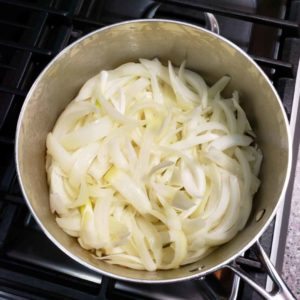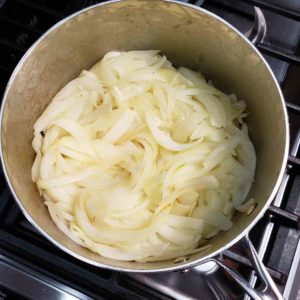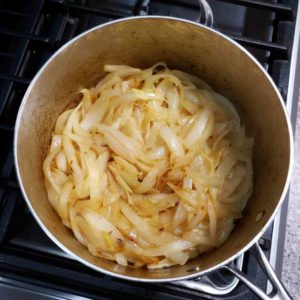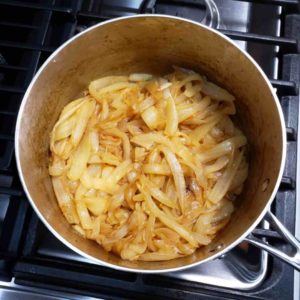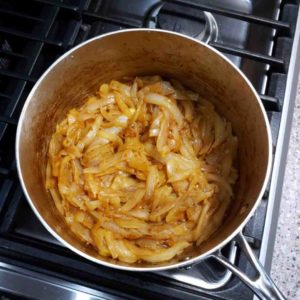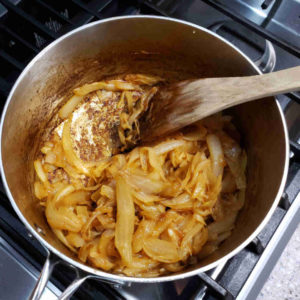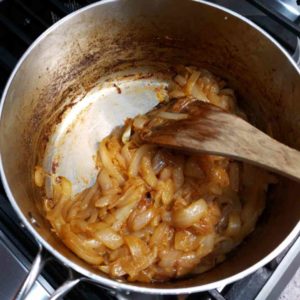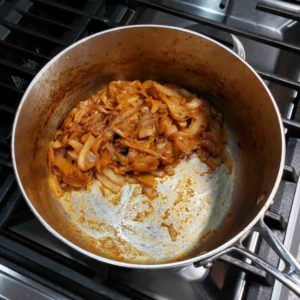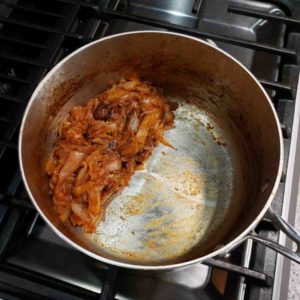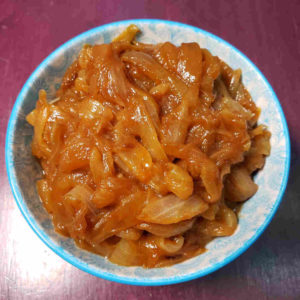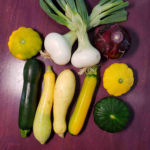Know that caramelized onions aren’t onions that you fry up quickly, finishing when they are soft, translucent state with some browning starting at the edges. Caramelized onions are a sweet, savory, jammy mess of umami. Getting raw onions to that state takes a little bit of technique and a lot of time.
Sitting down to write this, I performed an internet search on French onion soup recipes and surveyed the results. Understand, caramelized onions are the entire foundation of French onion soup. If there are any recipes that should get the concept right, it should be French onion soup recipes. Of the first five listed, here’s the total time spent caramelizing the onions:
- 30 minutes
- 40-50 minutes
- 25 minutes
- 45 minutes
- 50 minutes
There you go. None said 5, 10 or 15 minutes. Two stated questionable times between 25 and 30 minutes. But 3 out of five stated a reasonable 40 to 50 minutes. When I get ready to caramelize onions, I plan to spend 45 minutes and understand that it may take up to an hour.
Why do recipes underestimate the time to caramelize onions?
So why do recipes say you can caramelize onions in 5, 10 or 15 minutes? I always thought that editors put time restrictions on recipe authors. Total recipe time for a weeknight meal should be 30 minutes or less. For weekends, it’s OK to go up to 1 hour. Recipe authors do what they need to do to keep times within unrealistic constraints. Most recipes already deduct all of the prep time from their totals. When the ingredients list specifies things like chopped onions or minced garlic, the time to peel and chop or mince isn’t included in the recipe. Underestimating the time to properly execute individual steps is just another way to get within the maximum time constraints.
In This Will Make it Taste Good, Vivian Howard provides a whole chapter on how to make, and more importantly, how to use caramelized onions. She provides an alternate reasoning for recipe author’s chronic underestimation of time. First, she admits that she’s guilty herself. “I told people to “cook onions until caramelized, about 10 minutes” at least twenty-five times in Deep Run Roots, so the finger points back at me as anybody else.” Then she provides her reasoning. “What I meant by those instructions, and what I think most recipe writers mean, is “cook the onions as long as you’re willing and make sure they are brown in spots and not crunchy because that’s all I suspect you have time for.” OK. I can go with that. But, with all due respect to Ms. Howard (and I do have a lot of respect for her), recipe authors shouldn’t use the wrong term which leads to misunderstanding among the readers. If you mean “sauté until the onions are, soft, translucent and beginning to brown,” then go ahead and say just that. Anyway, the caramelized onion recipe in This Will Make it Taste Good indeed specifies 45 minutes of cooking time.
45 minutes? Really? Is it worth the time?
Why is it worth spending 45 minutes to caramelize onions? Because caramelized onions can make anything taste better. Kind of like bacon, except they’re vegan (if you use olive oil) or vegetarian (if you use butter). I use caramelized onions on pizzas, in pasta, on burgers, in grilled cheese, in savory galettes, mixed into egg dishes… Oh, and French onion soup on a cold, rainy day.
How to properly caramelize onions
How do you caramelize onions? First, ignore any “tips” on how to make the process faster. Don’t use a shallow, wide pan. Don’t add sugar or add baking soda. Do use a pot that allows the initial load of onions to form a stack, while not being so full that you can’t stir from the bottom without spilling onions over the sides. For 2 pounds of onions, I use a 3 quart sauce pan. For 4-6 pounds, I use an 8 quart pot.
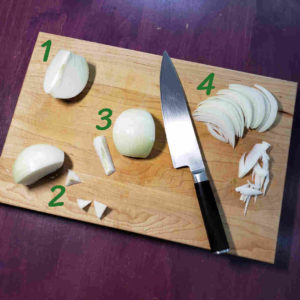
When you slice the onions, slice them top to bottom, through poles. My method to do this is to 1) Cut the onion into quarters and remove the peels. 2) Cut out and discard the root chunk. 3) Slice the remaining core, allowing the onion quarter to lie flat. 4) Slice into julienne. I tried to capture this in the accompanying picture.
The amount of fat to use is debatable, but I’ve settled on 1 tablespoon per pound of raw onion. I usually use butter, but olive oil also works if I intend to keep the final dish vegan. Also, adding ¼ teaspoon of salt per pound of raw onions helps draw out the moisture early in the cooking process and nicely seasons the final product.
The process goes something like this:
- Melt the butter over medium heat in an appropriately sized pot. If using olive oil, bring the pot up to temp on medium heat then add the oil.
- To make it easier to distribute the cooking fat, add about half of the onions and stir to coat. Then add the second half of the onions and, again, stir to coat.
- You can raise the temperature to medium high for the initial cooking process, but you will want to drop the temperature back to medium as the browning starts to occur.
- Early on, you can stir the onions every 5 minutes or so. As the process continues, you will have to stir more often. Towards the end, there is a lot of stirring!
- As the browning of the onions progresses, a brown film will develop on the bottom of the pan. This film is called a fond, and it is tasty! When you stir the onions, use a wooden spatula to scrape the fond off the bottom of the pan and incorporate it into the onions.
- As the browning progresses, there will be more and more fond, more and more stirring, and more and more scraping. A brown fond is delicious, but a burnt fond is disastrous. If things seem to get out of control where the fond is building up faster than you can keep up, there is an easy fix. Take the pot off heat, add a tablespoon or two of water. Stir things around so there is moisture all over the fond. Let things sit a minute or so, and then try scraping the fond again. You should find that it has loosened, and you can incorporate it into the onions. Once that is done, resume the caramelizing process over medium heat, with an increased amount of stirring and scraping.
What to expect
A sliced pound of raw onions fills a 4 cup measuring cup. By the time you are done caramelizing, the weight will be down to about 6 ounces and you’ll have a scant cup of caramelized onions. To make French onion soup, with 2 quarts of beef stock, you’ll need to start with 4 pounds of onions. To make a pasta dish, using one pound of pasta, where caramelized onions will be a co-star of the dish, you’ll want to start with 2 pounds of onions. Caramelizing 1 pound of onions will give you enough to top off 6 burgers or jazz up a similar number of grilled cheese sandwiches. But, it’s not practical to caramelize one pound of onions. If you are going to caramelize onions for a particular dish, go ahead and make more than you will need. They will easily keep in the fridge for a week and they freeze well. To freeze them, I like to half-fill zip lock bags. I lay the bags on their side, spread the caramelized onions out into a thin layer, and seal the bag with as little of an air pocket as possible. Freezing in thin blocks allows me to break off chunks to thaw as needed. Another idea is to get a jumbo ice cube tray and freeze the caramelized onions into ½ cup chunks.



